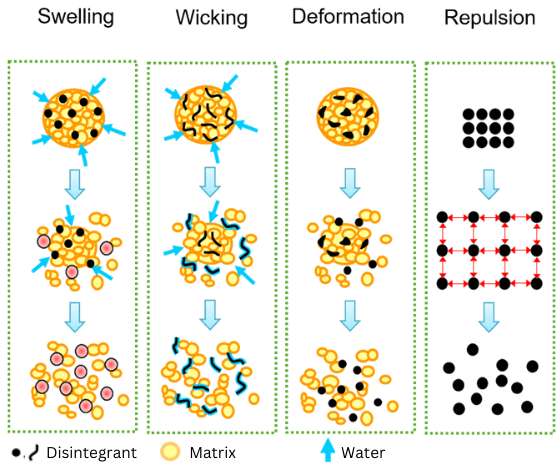1. What is a disintegrant?
After being taken with water, the tablet loses its shape in the stomach and dissolves the active ingredient, allowing it to be absorbed through the gastrointestinal tract. At this time, a "disintegrant" is added to solid tablets to absorb water and make them easier to crumble.
Therefore, disintegrants that absorb water and swell, disintegrating tablets, and facilitate the release of active ingredients are used as disintegrants.
2. Types of disintegrants
The disintegration pattern of disintegrants can be roughly divided into four types: swelling, wicking, particle deformation, and inter-particle repulsion.
Among them, Gotoku Chemical handles two types of disintegrants: the swelling type and the capillary phenomenon type.

(1)Swelling type
“Swelling” refers to the mechanism by which disintegrant particles swell due to water absorption, and the swelling force destroys the matrix structure of the tablet, causing the tablet to disintegrate. Carmellose calcium, low-substituted hydroxypropyl cellulose, corn starch, croscarmellose sodium, etc. are believed to be this swelling form. It is used according to the balance between two properties: swelling amount (how much it can absorb) and swelling speed (how strong the tablet can be broken).
(2)Capillary action, water conduction type(Wicking)
It is a mechanism that absorbs and swells moisture inside the tablet through the disintegrant, reducing the binding force between particles, and causing disintegration. In the case of wicking, the ability to absorb water into the tablet is more important than swelling. The key points are the amount of water it absorbs and the speed of wetting.
Generally, disintegrants need to be evenly distributed on the tablet surface, so there seems to be a tendency to add more disintegrants than swelling disintegrants. Microcrystalline cellulose, carmellose, is considered a water-conducting type.
It is said to be more effective when used with drugs that are relatively water-soluble.

